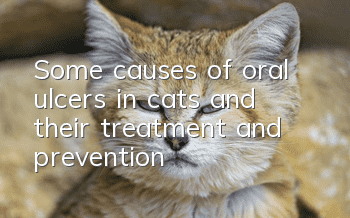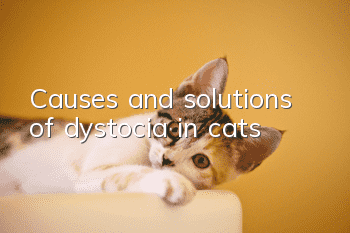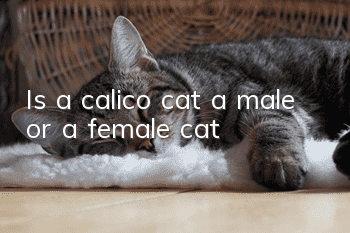Some causes of oral ulcers in cats and their treatment and prevention

Oral ulcers are also a common oral disease in cats. The veterinary community once had different opinions on the causes of oral ulcers in cats. Now it is generally believed that a defect in the immune system of cats is one of the causes of this disease, but there must be other factors. , these factors play a stimulating role.
1. Cause
Feline simple chronic gingivitis, which is a kind of unexplained gingivitis and stomatitis, can cause serious ulcers in cats' gums, tongue, pharynx and other parts, and conventional treatments often cannot cure it. The main factors that promote the development of feline stomatitis and gingivitis are: diet, oral cavity morphology, oral hygiene care, specific genetic characteristics and systemic infectious diseases, such as infection with feline HIV (FIV), feline leukemia virus (FeLV), Herpes virus, calicivirus, feline distemper virus, etc.; in addition, oral ulcers may also occur when diabetes, renal failure, and systemic lupus erythematosus occur; there is also a type of eosinophilic granuloma in cats that can also cause oral mucosal damage. Certain fungal infections can also cause lesions in the oral mucosa.
Other aspects include chronic inflammation caused by trauma. When a cat accidentally eats wood chips, iron wire, fish hooks, burrs, sewing needles and other foreign objects, it punctures its mouth, causing oral inflammation or ulcers; or it accidentally eats certain irritating drugs. Or chemicals can directly cause corrosive inflammation and burn inflammation in the oral cavity. Certain types of oral tumors, such as squamous cell carcinoma, gingivoma, etc. Tooth and gum diseases such as dental caries, dental abscess, dental calculus, gingivitis, and gum hyperplasia can also cause oral ulcers. Eosinophilic granuloma in cats can cause oral ulcers, and deformities of the teeth, hard palate, pharynx, etc. can also cause oral ulcers in cats. However, because the causes of oral ulcers in cats are very complex, there are still some cats with oral ulcers that cannot be diagnosed as to what caused them.
2. Clinical symptoms
1. Cats suffering from oral ulcers mainly show the following symptoms:
Long-term drooling. The amount of drool is related to the severity of oral ulcers. Sometimes blood is found in the drool. The drool is sticky and smelly. It usually wets the hair around the mouth, forelimbs and chest; There is severe bad breath; there is appetite but difficulty in chewing and swallowing. The affected cat often squats beside the food plate but does not eat. It is also careful when eating. Occasionally, it often screams when eating. Some cats shake their heads or use The claws scratch the mouth as if something is stuck; most cats will gradually lose weight; during oral examination, it is found that the gums are red and swollen, bleeding when touched lightly, the oral mucosa is flushed and swollen, and the gums, tongue surface, There are ulcers in the pharynx, soft palate and other parts of the body. The most serious ulcers are on the molars and premolars, followed by the pharynx and soft palate. Some cats will have loose teeth.
2. According to the severity of cat gingivitis and the oral cavityThe type of cavity lesion classifies gingivitis in cats into 4 grades.
Level 0: Normal gingiva.
Grade 1: Mild gingivitis, congestion can be seen in some places on the gingival edge, and there is no tissue hyperplasia.
Grade 2: Moderate gingivitis, gingival congestion but no signs of hyperplasia and/or gingival ulceration.
Level 3: Severe gingivitis, accompanied by congestion, redness and swelling of the gingival margin, gingival hyperplasia and ulcers; symptoms of periodontal disease, such as the formation of periodontal pockets, alveolar atrophy and loose teeth.
Level 4: Extremely severe gingivitis, manifested by extremely severe congestion, redness, swelling, hyperplasia and/or bleeding of the entire gum ulcer; pharyngitis, glossitis, loose teeth and brittle gum margins.
3. Differential diagnosis of several viral oral lesions
1. Feline herpes virus and calicivirus: These two viruses are the main causes of respiratory tract infections in cats, and are accompanied by ulcerative stomatitis, painful lesions on the tongue and soft palate; oral ulcers are common symptoms when infected by calicivirus .
2. Feline HIV: Chronic gingivitis and stomatitis are usually seen during infection; ulcers can occur on the tongue, gums, mucosa, and behind the molars, mainly caused by immune suppression; the ulcers are very painful and cause difficulty in swallowing. , anorexia.
3. Feline distemper virus: Mainly manifests as severe gastrointestinal symptoms; oral lesions include necrotizing gingivitis, severe ulcerative glossitis, soft palate ulcers, etc.
4. Treatment methods
Symptomatic treatment is difficult to cure completely. Removing necrotic tooth roots and calculus in the oral cavity according to the situation will be of great help to the improvement of the condition.
Commonly used conservative treatments are as follows:
① Antibiotics: metronidazole, amoxicillin, doxycycline, etc., mainly kill bacteria in the oral cavity and control secondary bacterial infections.
② Glucocorticoids: prednisone, dexamethasone - reduce immune response, reduce further damage caused by the body's immune response, and serve the purpose of anti-inflammatory and swelling.
③ Megestrol acetate: (mainly used to treat advanced breast cancer and advanced endometrial cancer, and also has certain effects on renal cancer, prostate cancer and ovarian cancer. It can also improve appetite and cachexia in patients with advanced tumors.) The purpose of using this medicine here is to enhance the body's metabolism and enhance physical fitness. This drug is contraindicated in unneutered female cats as it can cause breast and ovarian cancer.
④ Levamisole: Originally a roundworm repellent, its side effect is a very good immune enhancer. Can enhance the body's immunity. To achieve the purpose of strengthening the body. Do not use in pregnant animals as it may cause fetal malformations.
⑤ Multivitamins: Naturally, they are indispensable nutrients for the body. When problems occur in the oral cavity, it is oftenLack of many vitamins.
⑥Thyroxine: Promote metabolism and enhance physical fitness.
⑦Anti-inflammatory drugs: Reduce inflammatory response, reduce pain, redness and swelling.
⑧ Cyclosporine: immunosuppressant, reducing immune response.
⑨Analgesic drugs: Encourage animals to eat actively after pain relief.
Nowadays, surgical treatment is generally used. The cure rate of surgical treatment of cats is very high, so I will not describe it here.
5. Prevention of oral ulcers
First of all, cats must be vaccinated regularly to prevent the viral diseases mentioned above that can cause oral ulcers; secondly, the cat’s daily diet must be rich, diverse and nutritious. You can also feed the cat some meaty bones to It plays the role of cleaning the oral cavity and strengthening the teeth; third, check the cat’s oral cavity frequently to see if any abnormalities are found, such as whether there are red and swollen gums, foreign bodies or wounds, lumps, dental caries or calculus, whether the cat has Bad breath, etc.; Fourth, wash your cat’s teeth or clean its teeth and mouth regularly.
In the past, oral ulcers in cats were an incurable disease. Now, with the development of medicine, the cure rate of oral ulcers in cats has been greatly improved. At home, we often provide oral care to cats, which is very beneficial to the prevention of oral diseases in cats.
- How to tame a British Shorthair cat
- There are many fleas, how to deworm cats externally?
- Do cats eat sausages?
- What money must be spent on raising a cat?
- What causes red pimples on a cat’s chin?
- What should I do if my cat doesn’t eat hair removal cream?
- What should I do if my female cat is in heat and keeps meowing?
- Reasons why cats grind their claws and scratching training
- What are the signs that a cat is about to give birth?
- What do Ragdoll cats eat to make their hair pop?



